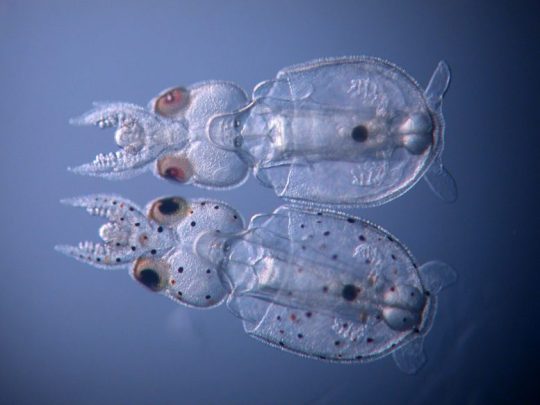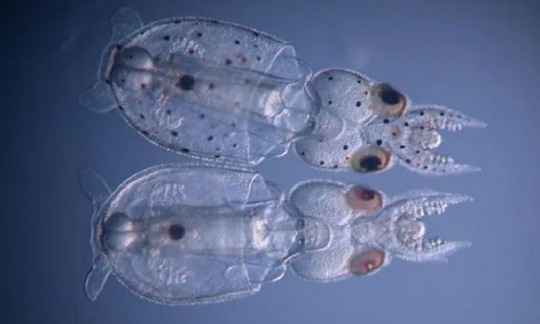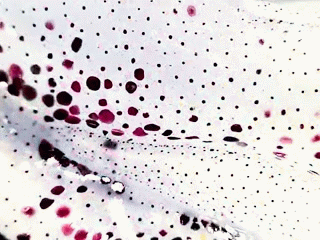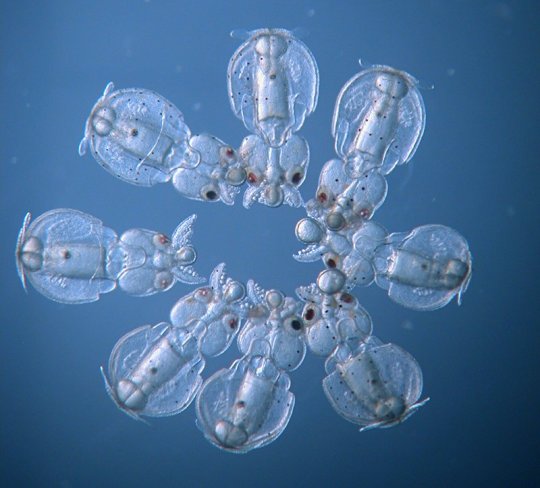#doryteuthis pealeii
Text

Longfin squid
2 notes
·
View notes
Text
Ahtapotlar Neden Bu Kadar Akıllı?
Ahtapotlar Neden Bu Kadar Akıllı?
Ahtapotlar Neden Bu Kadar Akıllı?
Ahtapotlar hayvanlar aleminde en gelişmiş sinir sistemine sahip hayvanlardan biridir. Bilim insanları ahtapotların bu kadar akıllı olmasının nedeninin yendiden yapılanmalarına borçlu olduklarını düşünüyorlar. Midye benzeri diğer hayvanlarda dağınık olan genetik materyal, ahtapotlarda birleşerek birkaç sinir hücresi geninden oluşan grupları meydana getiriyor. Bu…

View On WordPress
#Ahtapotlar Neden Bu Kadar Akıllı?#Doryteuthis pealeii#Euprymna scolopes#Hawaii kısa kuyruklu kalamar#Kaliforniya iki benekli ahtapotu#Octopus bimaculoidesi#uzun yüzgeç kıyı kalmarı
0 notes
Note
Hello,
Thank you for answering my ask about the squid article! Good to know that that’s not a real thing.
Also what kind of squid is the squid in your profile pic if you don’t mind me asking?
That's a Doryteuthis Pealeii, caught off Cape Cod way the hell back in 2009
23 notes
·
View notes
Text
Squid and human brains develop the same way despite diverging 500 million years ago#Squid #human #brains #develop #diverging #million #years
Scientists who watched nerve cells connect inside the eyes of growing squid have uncovered a remarkable secret — the cephalopods’ brains independently evolved to develop in the same way ours do.
The discovery, made using high-resolution cameras focused on the retinas of longfin squid (Doryteuthis pealeii) embryos, reveals that, in spite of 500 million years of divergent evolution, the basic…

View On WordPress
0 notes
Link
There are currently four different Gene Editing Techniques, including CRISPR-based technologies, which are designed to cure human disease by repairing the genetic code of their DNA. Researchers from the Marine Biological Laboratory (MBL) in Woods Hole, Massachusetts, have found that squid can edit its genetic code. The discovery could potentially...
#Health#Nature#Science#adenine#axon#biological secrets#cell nucleus#cellular machinery#changes to the DNA#Coding modifications#creatures#Crispr-based technologies#Cure Human Diseases#cytoplasm#Denver#DNA#DNA editing#Doryteuthis pealeii#edit its own genetic code#FDA#fruit flies#Gene Editing Techniques#gene editing-based drugs#gene editing-based treatments#gene editing-based vaccines#gene-editing#genetic disorder#genetic disorders#genome#guanine
36 notes
·
View notes
Text
Squid pigments have antimicrobial properties
https://sciencespies.com/biology/squid-pigments-have-antimicrobial-properties/
Squid pigments have antimicrobial properties


Diagram with the stages of the study. The main ommochrome identified in squid skin is xanthommatin. Credit: Chan-Higuera et al.
Ommochromes, the pigments that colour the skin of squids and other invertebrates, could be used in the food and health sectors for their antioxidant and antimicrobial properties. This is confirmed by analyses carried out by researchers from the University of Sonora in Mexico and the Miguel Hernández University in Spain.
One of the squid’s best-known characteristics is its ability to change its colour to blend in with the environment, which it does by contracting or relaxing skin cells known as chromatophores.
Now, scientists at the Miguel Hernandez University in Elche (Spain) and the University of Sonora in Mexico have discovered that these cells contain a type of violet pigment, called ommochrome, which has antimicrobial, antioxidant and antimutagenic properties.
“When we add extracts of these squid pigments to bacterial cultures like Listeria monocytogenes, Salmonella enterica, Staphylococcus aureus or Haemophilus influenzae, or to fungi like Candida albicans, the growth of microorganisms is inhibited,” says Jesús Enrique Chan, a researcher at the two universities and co-author of the study.
“Moreover,” he adds, “ommochromes act as antioxidants, binding or ‘sequestering’ metals and eliminating such radicals as an active oxygen called singlet and superoxide anions. We’ve identified the best temperature, time and proportion conditions with solvents so as to obtain its greater antioxidant and antimicrobial activity, as well as its antimutagenic capacity against agents such as aflatoxin B1 (a mutagenic mycotoxin).”
The study, published in the Journal of Microbiology, Biotechnology and Food Sciences, concludes that cephalopod ommochromes are the components responsible for all these beneficial properties and highlights: “They are pigments with a promising therapeutic value, which could be applied in the future in both the food and health sectors.”
In order to carry out their research, the authors have used samples of the giant squid (Dosidicus gigas), a species that is caught on the Pacific coast of America and which is mainly used for its mantle and tentacles. The rest, including its skin, is regarded as fishing waste and dumped into the sea.
“This generates pollution problems on the coasts,” says Chan, “so research like this, in which we inform about how these wastes could be used, helps to revalue them and minimise their dumping into the environment.”
The main ommochrome identified by scientists is xanthommatin, a pigment found in other common squid (Loligo vulgaris, Doryteuthis pealeii…), cuttlefish (Seppia officinalis) octopus (Octopus vulgaris) and other invertebrate species, from which this beneficial compound could also be extracted.
Explore further
Video: The future of sunscreen begins with cuttlefish
More information:
Jesús Enrique Chan-Higuera, Jumbo Squid (Dosidicus Gigas) Skin Pigments: Chemical Analysis And Evaluation Of Antimicrobial And Antimutagenic Potential, Journal of Microbiology, Biotechnology and Food Sciences (2019). DOI: 10.15414/jmbfs.2019.9.2.349-353
Provided by
Spanish Foundation for Science and Technology (FECYT)
Citation:
Squid pigments have antimicrobial properties (2019, December 5)
retrieved 5 December 2019
from https://phys.org/news/2019-12-squid-pigments-antimicrobial-properties.html
This document is subject to copyright. Apart from any fair dealing for the purpose of private study or research, no
part may be reproduced without the written permission. The content is provided for information purposes only.
#Biology
2 notes
·
View notes
Photo

Doryteuthis pealeii
Atlantic Longfin Squid
ft. Casey Zakroff
Compared to the bottom-dwelling slugs or sea stars, squid are peculiar invertebrates. Despite their lack of backbones, these predators swim in the open waters — behaving more like fishes. But just like everything else in nature, there’s always an exception.
“It’s built to be a visual, pelagic hunter, yet it often rests on the seafloor,” Casey says about his study subject, the peculiar Atlantic longfin squid.
It is one of the better-known species in biology, having appeared in studies like neurobiology and camouflage science. But just like its weird lifestyle, it constantly surprises scientists in so many different ways.
For his research, he photographed baby squid in water droplets under the microscope to measure their growth.
“They have this little hexagon on their head. It’s the first thing I look for to see if I need to flip them over, which can be arduous as they are sticky little buggers.”
His squid were raised in tanks that simulate an extreme condition called ocean acidification. This is a global phenomenon that happens when a large amount of CO2 dissolves into the ocean, making it more acidic.
Usually, this phenomenon happens over a long period of time due to the fluctuations in our atmosphere. These days, it’s happening faster than the natural rate because humans are dumping CO2 into the atmosphere.
It turns out, higher levels of CO2 make Casey’s squid grow slower and hatch later.
This slower growth affects their swimming speed and control, which in turn may hinder their survival. This is crucial not just to the squid, but also to the countless other species that are connected to them in the food chain, including humans.
Such a global change affects all marine inhabitants, though some places and species will be more impacted than others. Animals that rely on coastal ecosystems like the longfin squid, for example, are more vulnerable because of their proximity to human settlements.
Right now, scientists are tackling global environmental challenges from many different angles. Tiny as they may seem, Casey’s squid squad is helping us understand how nature responds to a new world sculpted by mankind.
—
Casey Zakroff is a PhD Candidate at MIT-WHOI. Get to know Casey and his squid squad.
Twitter · Lab · Research video · Podcast twitter · Podcast website
—
My main blog · Ko-fi · Patreon
361 notes
·
View notes
Text
Octopus mystery: how do they see color?

Eye of a cuttlefish. Note the W shaped pupil. (Image from Wikimedia Commons)
The eyes of cephalopods like octopus, squid, and cuttlefish possess only one kind of photoreceptor, implying that they are colorblind, being able to see only in greyscale. But wait! They are famous masters of camouflage, being able to blend with their surroundings, and they signal each other in intricate color patterns. These feats suggest that they are not colorblind.
Two main hypotheses to explain this mystery are (1) they also see with their skin (Wardill et al. 2015) or (2) they make use of chromatic aberration (Stubbs & Stubbs 2016).
Cephalopods certainly do possess photosensitive molecules called opsins in their skin, so potential exists for cephalopods to detect light with their skin. However, the photosensitive molecules in the skin are like those in the eyes, so it’s not clear how that would help them see color any better than the eyes do.
Chromatic aberration is the differential bending of light of different wavelengths (colors). That’s how a prism splits white light, and why when your eyes get dilated by the eye doctor, besides things becoming blurry, you also see rainbows around things. Light of different wavelengths passing through a lens has different focal points. For most organisms and for human-made optical devices, chromatic aberration is a problem to be minimized.
The chromatic aberration hypothesis proposes that instead of avoiding chromatic aberration, cephalopods enhance it using their peculiar off-axis pupil shapes. This enhancement allows them to detect color by monitoring image blurring as focus changes. Computer models show that this method of image detection is possible.
Such use of chromatic aberration could explain why cephalopods have such bizarre pupil shapes. The pupil in some octopuses is an elongate slit, and in cuttlefish, it is the shape of a W.
These two hypotheses yield different predictions under certain circumstances, such as colors on a flat field (for which focus would not change). Now we await results of experiments testing between these two possibilities. Then we will have an answer for how cephalopods can see color, despite having the appearance of being color blind. We might need to re-evaluate other creatures that have been labeled colorblind.
Timothy A. Pearce is Curator of Collections, Section of Mollusks at Carnegie Museum of Natural History. Museum employees are encouraged to blog about their unique experiences and knowledge gained from working at the museum.
Literature cited
Kingston, A.C.N., Wardill, T.J., Hanlon, R.T. & Cronin, T.W. 2015. An unexpected diversity of photoreceptor classes in the longfin squid, Doryteuthis pealeii. PLoS ONE 10(9): e0135381. doi.org/10.1371/journal.pone.0135381
Stubbs, A.L. & Stubbs, C.W. 2016. Spectral discrimination in color blind animals via chromatic aberration and pupil shape. Proceedings of the National Academy of Science U.S.A.113: 8206–8211. doi: 10.1073/pnas.1524578113
#Carnegie Museum of Natural History#Mollusks#Mollusca#Cephalopods#Octopus#Squid#Cuttlefish#Colorblindness#Eyesight#Science
27 notes
·
View notes
Text
The genes that make squid eyes also make your legs | Science
Koenig Laboratory
PROVIDENCE—Looking a squid in the eye is strangely like searching in a mirror. Squids, octopuses, and other cephalopods are on an extremely various part of the tree of life from vertebrates. However both have actually progressed advanced peepers that count on a lens to focus light and offer exceptional vision. This independent advancement of such intricacy has actually puzzled biologists for centuries and has actually triggered searches for clues about how this may have happened.
Evolutionary developmental biologists have actually now found that the genes that direct the preliminary development of legs in us and other vertebrates also direct the development of the squid’s lens (seen in sample of eye above). The discover is yet another example of how nature employees genes utilized for one function to do another task for the body.
The squid lens forms as extra-long membranes jutting out for specialized eye cells overlap to form a tight ball. Our lenses are really deteriorated cells themselves loaded with a clear protein. To discover how the squid lenses form, these scientists thoroughly tracked where, when, and which genes turn on and off as embryos of Doryteuthis pealeii, a squid frequently acted as fried appetisers, establish.
They were amazed to see the gene regulative network for growing limbs at work in an establishing eye. However when they included a chemical called WNT that naturally hinders this network in lots of organisms to squid embryos, the lens failed to form, they reported here last month at Development 2019, a yearly conference of evolutionary biologists, verifying this limb network is also a lens network. Next, the scientists will peer into precisely what each of these genes is doing to make the lens type.
New post published on: https://livescience.tech/2019/07/16/the-genes-that-make-squid-eyes-also-make-your-legs-science/
0 notes
Text
El calamar invisible: primer nocaut genético en un cefalópodo logrado
El calamar invisible: primer nocaut genético en un cefalópodo logrado

[ad_1]
Doryteuthis pealeii, a menudo llamado calamar Woods Hole. Los estudios con D. pealeii han dado lugar a importantes avances en neurobiología, incluida la descripción de los mecanismos fundamentales de la neurotransmisión. El Laboratorio de Biología Marina recolecta D. pealeii de aguas locales para una comunidad internacional de investigadores. Crédito: Roger Hanlon
Los avances en la…
View On WordPress
0 notes
Text
Mực biến đổi gene đầu tiên trên thế giới

Các nhà khoa học thông báo tắt thành công gene sắc tố ở loài mực có tên Doryteuthis pealeii, khiến con non mới nở gần như trong suốt.
0 notes
Photo

Scientists achieve gene knockout in a cephalopod for the first time Scientists working in the Marine Biology Laboratory at the University of Chicago have announced a breakthrough. The team has achieved the first gene knockout NSF pod using the squid Doryteuthis pealeii.
0 notes
Photo

Doryteuthis pealeii's getting feisty
489 notes
·
View notes
Photo

«Зашитые» в кожу белки из глаза помогают кальмару менять окраску.
Чтобы замаскироваться от врага или привлечь особь противоположного пола, кальмары вида Doryteuthis pealeii могут менять свою окраску за счет сложного строения кожи. По ее поверхности распределены особые образования, хроматофоры, в каждом из которых находится окруженная расходящимся кольцом мышц капсула с окрашенными клетками. Сокращение мышц растягивает капсулу, делая ее более заметной; под капсулами находится еще один слой клеток клеток, также обладающих интересными оптическими свойствами.
Пигментная капсула (вид сверху и вид в разрезе) вместе с лежащими под ней клетками (показаны желтым на левом изображении)Roger T. Hanlon & Leila F. Deravi et al. / Nature Communications
Если клетки в капсуле, которая изменяет свою форму, просто поглощают свет с определенной длиной волны (цветом), то клетки нижнего слоя могут столь же избирательно отражать свет. При этом их поверхность переливается радужными красками. Долгое время изучающие этих головоногих биологи думали, что между хроматофорами и нижним слоем есть четкое разделение по оптическим свойствам (сверху пигменты, снизу — радужные частицы). Однако новое исследование показало, что в самих капсулах-хроматофорах есть две разных по своим свойствам молекулы.
Хроматофоры из кожи кальмара Doryteuthis pealeiiStephen Senft / Hanlon Lab, MBL
В своей статье для журнала Nature Communications биологи пришли к выводу, что хроматофоры кальмаров используют сразу два разных способа управления светом: пигментный и структурный. Первый основан на том, что хроматофоры избирательно поглощают определенные цвета (так работает большинство красителей). Структурное управление светом предполагает совсем иной механизм. Иризация возникает не потому, что молекулы поглощают какие-либо определенные фотоны, а за счет особой геометрии поверхности. Схожий эффект проявляет состоящий из прозрачного вещества мыльный пузырь или масляная пленка на поверхности воды.
Белый свет представляет из себя смесь волн с разной длиной. Если такие волны отражаются от какой-либо поверхности и накладываются друг на друга, то они могут как усиливаться, так и взаимно уничтожаться. Так как судьба волны напрямую зависит от ее длины и, следовательно, цвета, то отраженный и прошедший через сложение волн белый свет оказывается лишен тех или иных составляющих. В результате его цвет меняется.
Используя методы молекулярной биологии, ученые выяснили состав белков, из которых состоят хроматофоры. Ими оказались кристаллины, похожие на белки хрусталика в глазах млекопитающих; свойственные многим головоногим и входящие в переливающийся слой кожи рефлектины, а также светочувствительный родопсин. Последний позволяет хроматофору реагировать на изменение света даже в том случае, если связь с нервной системой потеряна.
Кроме того, ученые детально изучили микроструктуру хроматофора и выяснили, где сосредоточены те или иные белки. Эта информация позволила не просто выяснить, почему кальмары могут быстро — за ⅛ секунды — менять свою окраску, но и дала подсказку для инженеров, которые разрабатывают подобные покрытия. На схожей комбинации двух разных физических принципов, используя деформируемые гранулы с разными оптическими материалами можно, как считают авторы новой работы, сделать принципиально новые покрытия для чего угодно.
https://ift.tt/2tWlZ05
0 notes
Text
First genetically modified squids are born transparent after scientists 'knock out' pigmentation gene in embryos that controls eye and skin cell color
First genetically modified squids are born transparent after scientists ‘knock out’ pigmentation gene in embryos that controls eye and skin cell color
For the first time in history, scientists have genetically altered squid embryos by removing a pigmentation gene that resulted in transparent creatures.
The team used CRISPR-Cas9 to ‘knock out’ the gene in a Doryteuthis pealeii and in turn eliminated coloring from the eyes and skin cells.
The procedure involved clipping the egg’s tough outer layer with micro-scissors and delivering the reagents…
View On WordPress
0 notes
Text
For the first time, CRISPR gene-editing has been used on squid
https://sciencespies.com/nature/for-the-first-time-crispr-gene-editing-has-been-used-on-squid/
For the first time, CRISPR gene-editing has been used on squid

For the first time, the innovative CRISPR gene editing method has been used on squid, marking a milestone in the scientific study of these creatures – and opening up many new areas of potential research.
CRISPR enables very precise, speedy, and low-cost DNA edits. Put simple, the ingenious molecular workings of the method are often described as something that allows us to ‘cut’ and ‘paste’ genes; in humans it promises to give us a way of tackling disease and killing superbugs at the genetic level.
In this case CRISPR-Cas9 genome editing was used on Doryteuthis pealeii (the longfin inshore squid) to disable a pigmentation gene, turning off the pigmentation usually found in the squid eye and inside specialised skin cells called chromatophores.
“This is a critical first step toward the ability to knock out – and knock in – genes in cephalopods to address a host of biological questions,” says marine biologist Joshua Rosenthal, from the Marine Biological Laboratory (MBL) at the University of Chicago.

CRISPR-Cas9 squid hatchlings. (Karen Crawford)
The longfin inshore squid is of huge interest to scientists, and studies of Doryteuthis pealeii going as far back as the 1950s have helped to make significant contributions to the field of neuroscience – including the first description of the nerve impulse.
Cephalopods (squid, octopus and cuttlefish) have larger brains than all other invertebrates, the ability to recode their own genetic information, and some rather amazing party tricks (such as being able to change colour instantaneously).
Being able to edit genes in these creatures is a major new development, and one which could see squid join the ranks of model organisms in genetic research, such as fruit flies and zebrafish. The study of evolution, medicine, robotics, materials and even artificial intelligence could all benefit.
“They’ve evolved these big brains and this behavioural sophistication completely independently,” Rosenthal told NPR. “This provides an opportunity to compare them with us and see what elements are in common, and what elements are unique.”
What makes this new achievement such a success is the delicate way in which CRISPR had to be applied: getting past the tough outer layer of the single-celled squid embryo with micro-scissors and a quartz needle, and then hatching it.

Doryteuthis pealeii in the water. (Roger Hanlon)
The timing of the edits was crucial, but after a lot of false starts (and broken needles) the team was able to develop embryos with fewer pigmented cells and lighter eyes.
It’s hoped that because these squid are masters at editing their own genetic code, this research could push our own techniques even further. The next step is to try the technique in smaller types of squid that are easier to raise (and study) in the lab.
In the future, this method will be massively useful for researchers testing the function of certain squid genes, and tracking genes that control neural activity in the creatures – all options that simply haven’t been available before.
“Now we actually have the ability to go in and test what an individual gene does,” marine biologist Carrie Albertin, from the MBL, told NPR.
“This is something that honestly, if you asked me five years ago if we’d be able to do, I would have just giggled and said, ‘I dream of it’. But, you know, I didn’t think it would be possible. And yet here we are.”
The research has been published in Current Biology.
#Nature
0 notes